Around midday on Saturday, May 27, 2000—the day that Eunice, Louisiana exploded—I was by sheer coincidence a tourist on foot in that small, Cajun Prairie town of about 11,000. A recent law school graduate, I had traveled to the town with my law school buddy Sam and his fiancé. Sam’s family roots were in Eunice, and we were staying with his grandparents.
That morning started like any other. I knew that Sam’s grandmother was stirring as the smell of strong coffee and her first cigarette of the day wafted under the cardboard-thin door of my bedroom. We were summoned to the front porch where we tucked into a breakfast of boudin sausage stuffed with rice and liver, washed down with their preferred seven-ounce short beers, already sweating in their bottles.
Unattached and in my early twenties, time held me green, and I was full of good feeling for the place and its people. In truth, I was a little smitten with Eunice, a town like a slapdash junction box for the pulsing currents of Cajun Culture. The circuit might have been janky, but it always had the juice, and it hardly resembled the packaged version of Cajun country on the store shelves of New Orleans. A happiness-before-things culture pervaded the place. Zydeco music and folkways were awfully seductive distractors at a moment when I faced a series of personal losses. That same year, I mourned my grandfather, a plucky Greatest Generation brawler who emerged from a coal mining town to a storied career as a chemist that probably came at the cost of the lung fibrosis that felled him. Still in grief, I was simultaneously looking for a conclusion to a protracted break-up with a longtime girlfriend.
Eunice offered a place to look for some embers in the ashes; with a Cajun-format radio station and dancing quite literally in the streets, the town’s very culture seemed to resist grief. There, I could process something else that I had pushed to the shadows, the furtive and rising awareness of a fact that I had barely managed to conceal from myself—that I was poorly suited to a career in law, notwithstanding the environmental idealism that had carried me to law school. I had followed one of Sam’s relatives to a barefoot squirrel hunt in a vast bottomland of live oaks; sipped drinks with, and stolen glances at, his stunningly beautiful, no-nonsense cousin; and gotten my hair cut in a pleasantly lackadaisical homespun barbershop parlor where the old timers spoke, exclusively, Cajun French. The place stood as far from the brutalist architecture and equally brutalist class-long briefings of my 1-L classrooms as east is from west.
And then came the first explosion during that afternoon walk, quickly changing my status from tourist to bystander, and then to refugee/evacuee.
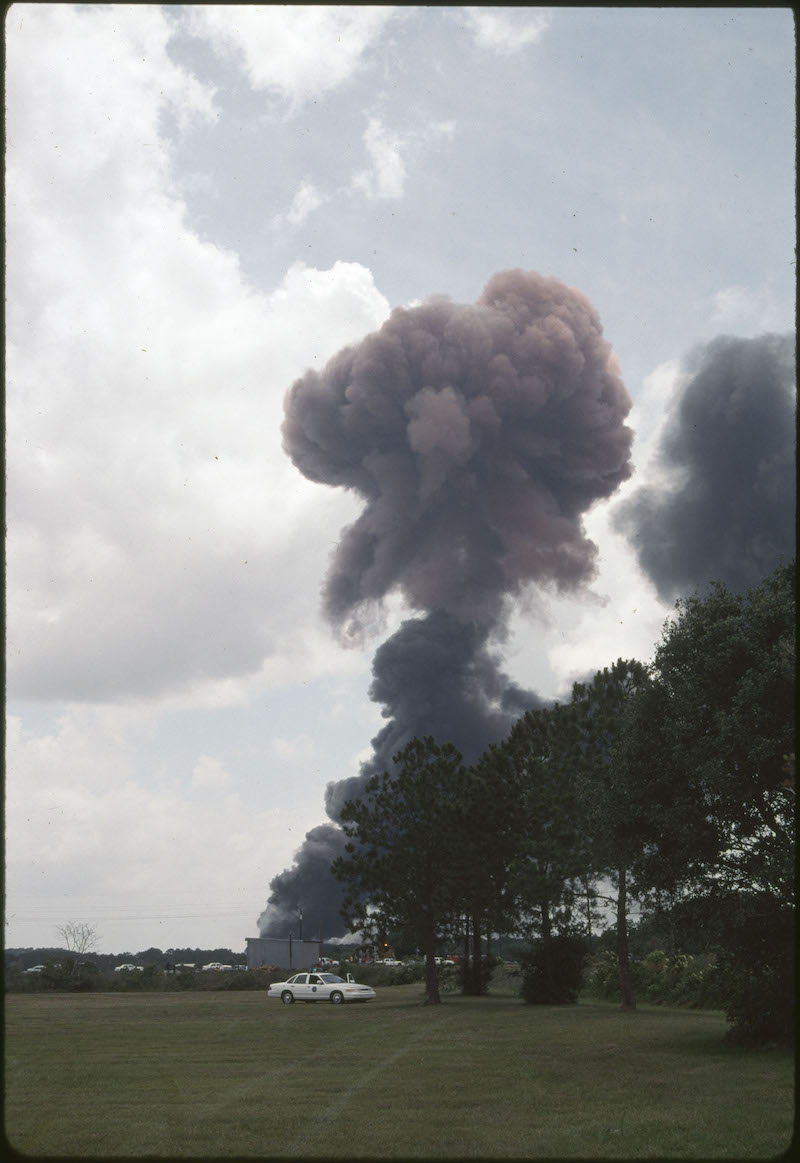
According to the official report, “The St. Landry Parish 911 Center received the first call at 11:48 a.m. The call came from someone at the Eunice Country Club with a cellular telephone”—still something of a novelty then. I couldn’t see the source of the detonation, but from the kick in my chest I knew that it was powerful enough to shatter windows. Immediately, a pink mushroom cloud rose on a smoky column to spread overhead, and people in various states of dress began to poke their heads from screendoors while I started snapping photos. As I would later learn, I was standing about a half mile from where 33 of the 113 cars of Union Pacific’s Train QFPLI-26 had derailed (going forward, the UP-26). It regularly plied its cargo along one of the nation’s busiest aboveground petrochemical transportation routes. Eunice was another whistlestop town along the infamous Cancer Alley, a petrochem travel corridor of some 150 plants and refineries extending along Louisiana’s river parishes, from New Orleans to Baton Rouge.1
The train had originated in Houston, taken on a fresh early morning crew in Beaumont, and then set out for Livonia, Louisiana, outside of Baton Rouge. Around the bend from where I stood, and still out of direct view, part of UP-26’s toxic payload was on its way into an unnamed tributary of a bayou lake; other cars were perched precariously on the rim of it, some broken up along the right of way and a small trestle spanning a drainage slough.
As the disaster unfolded on that muggy morning, a nervous festival atmosphere prevailed. Some townspeople parked where could get a better vantage on the spectacle and cracked open beers. But the emergency personnel were growing more alarmed and insistent, and it was clear that no one knew exactly what could happen next. I was miles from Sam’s grandparents’ house. With sweat beading visibly through his brush cut, a police sergeant kept threatening to arrest me if I didn’t leave Eunice right away. In exasperation, I pointed out that the only way I could leave the place in a hurry was in the back of his car.
“He can go with us,” said a soft voice behind me. A Cajun paterfamilias was gesturing toward his Mercury. His family had grown restive, but their attitude toward the officials was distinctly cool and unhurried. I climbed in, deeply relieved to be voluntarily in the family’s car instead of trespassed in a patrol car, as he turned the key.
I’ve always been shy about taking documentary portraits, which seem so invasive. But the disaster brought a rare and instant intimacy with the Cajun family that transported me to their home. Such a moment called for the best witness I could give, even though we did not know if we would ever see one another again. Another thing that I could not see from the year 2000, that seventeen years later I would coauthor with my Cajun friend and colleague Maria Hebert-Leiter a retrospective book on the Farm Security Administration photographers in Lousiana, observing how the Louisianans the federal photographers documented were very often visibly wary of their intrusions. I think I took the family photo in Eunice almost apologetically, in haste, because I could not hug them. It’s a force majeure portrait that sums up the character of the people I encountered there. Their ancestors had faced expulsion across a continent, and it was going to take a lot more than a Louisiana state policeman to move them. As the smoke rose in the sky behind them, they stood together, as a family, as they faced a fresh disaster, or turned their backs on it. Anxiety, stranger-shyness, pride and pluck, self- and family-possession are written on their faces. They weren’t going anywhere, they told me.2
To this day, I’m haunted by that image, and the inadequacy of whatever thanks I offered them in the moment—now that I’m a father, and I know what it means to open the circle, to make room in the life raft, in time of disaster.
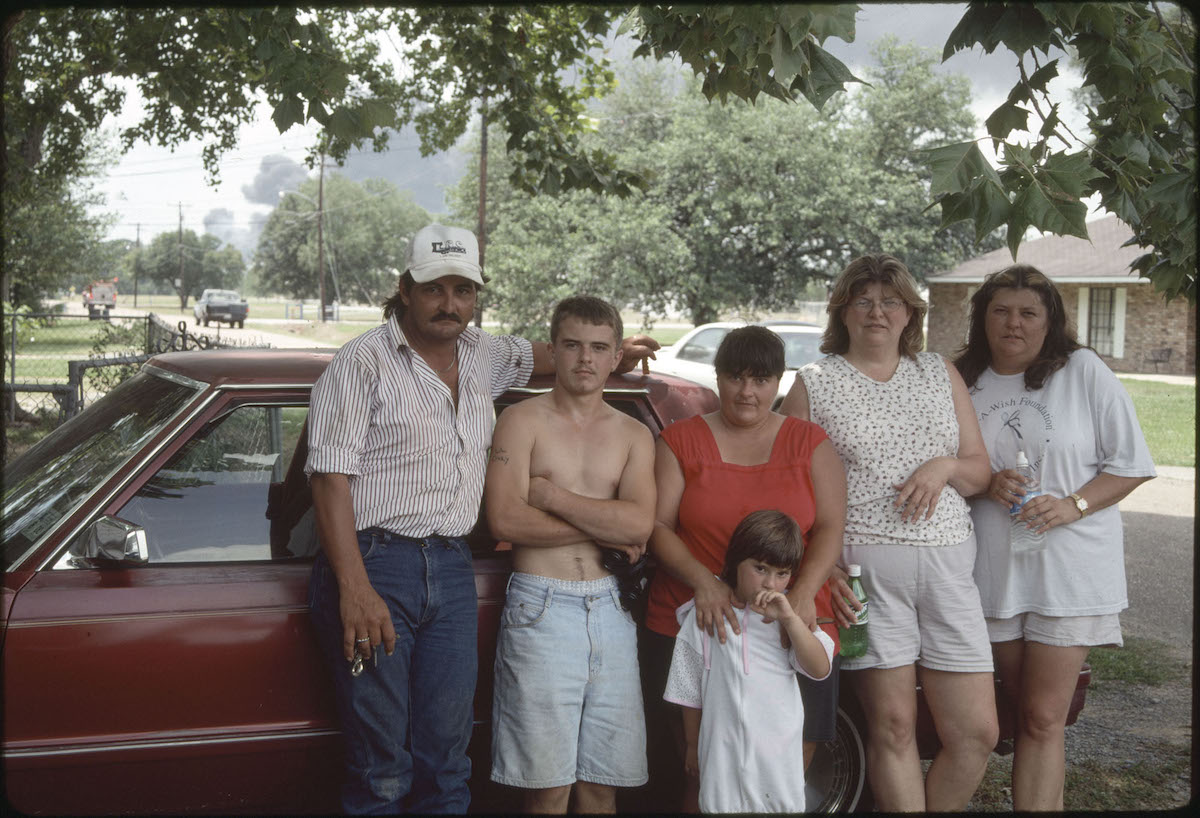
Equally, as a father now, I’m haunted by all the danger they could not escape and that would remain in their back yard. Fifty-six of the cars carried hazardous materials or their residues. Forty of these were fully loaded, and seventeen of the derailed cars were carrying toxic materials, in that inevitable cliché, a witch’s brew representing a typical cross-section of the innumerable products and byproducts gleaned from various stages of refinement in oil and natural gas extraction.
By comparison, the February 3, 2023 accident in East Palestine, Ohio, involved fifty derailed cars, ten of them with dangerous chemicals that made, as the Washington Post reported, a “toxic soup.” Observing the continuing media interest in the wreck at East Palestine, which has persisted, remarkably, beyond a single news cycle, I feel a (shameful) sense of sibling rivalry, of being upstaged by mom and dad fussing over a kid brother. Or perhaps a northern cousin. In 2000, the story of the Eunice derailment and wholesale town evacuation was back-page news for a few days before sinking from national view; the vapors and trauma that lingered were for the residents to figure out on their own. When the Eunice derailment happened, nobody seemed to care much about it; today, everyone seems to care, or say they care, about East Palestine.
Recurring disasters of our own making can hardly be called accidents.
To harbor such a jealousy, even a fugitive one, seems a sad proof of colonization of the mind, the pride of being squarely last. Yet, I can also see the good of East Palestine’s surprising staying power: maybe, just maybe, twenty years on, we are paying more attention. Hurricane Katrina raised the dauntless Cajun Navy, after all. Louisiana writer Walker Percy, who did not live to see Katrina, once mused on the redemptive power of Louisiana’s hurricanes in his novel Lancelot (1977): “True, people help each other in catastrophes . . . But they don’t feel good because they help each other. They help each other because they feel good.”3
The jouissance of Mediterranean Catholicism, which Percy adopted as his own, always seemed to favor Carnevale over Easter’s season of mourning. As a southern-born Catholic, I could relate; our household’s reliable Christmas Eve party was a popular oasis for not-so-teetotaling Protestant neighbors. In 2000, I was a law student reading voraciously and evasively in the eaves, plowing methodically through Percy’s novels as an antidote to casebooks. Like Percy, I was a reluctant professional in training, already headed for the tracks. His worldview seemed lovely and defiant and romantic to me then, a way to say, If you’re on the ship of fools, at least put on dancing shoes for the deck party.
But recurring disasters of our own making can hardly be called accidents. Twenty-three years on, with the climate emergency in effect, mixing drinks and moving the deck chairs to the prow feels like futility and an insult to my teenaged son and daughter. And so does East Palestine, a Eunice for the next generation.
Of particular concern to the authorities in Eunice, it turned out, was a car bearing a load of molten phenol. Molten, because it must be shipped at high temperature to remain semi-solid, and so toxic that its vapors alone can cause severe chemical burns. One car carried residue of thiapentanal, and there were entire cars of acrylic acid, dichloropropane, dicyclopentadiene, and pentanes; two each of toluene diisocyanate, methyl chloride, and hexanes; and four bearing unspecified “corrosive liquids.”
When I first steeled myself to revisit the history of this disaster, which federal reports refer to simply as a derailment, I looked at the off-putting names of those chemicals and was tempted to pass by them altogether. We tend to assume that these chemicals exist austerely, quite separately from us as we go about our business, within the impenetrable and highly regulated domain of specialized technologies (like artificial intelligence) that don’t bear much looking into, and that can’t be understood by lay people. But this isn’t true. You can look them up readily, as I did, on the NIH, EPA, and state health hazardous materials registries (and in the case of the Toxic Release Inventory, you can see how many millions of pounds of industry-reported toxics are being released in your state). Even the most arcane-seeming substances, like 3,6,9,12,15,18,21,24,27-Nonaoxanonacosan-1-ol, 29-(nonylphenoxy)- (first regulated by the EPA in 2014) can be understood with a little looking around. The EPA risk management plan explains that it’s part of a class of common industrial chemicals, added to things like detergent, that are extremely toxic to aquatic organisms and that can mimic hormones after entering the human body.4
Citizen scientists like those in the Louisiana Bucket Brigade, many of them African Americans inspired by Nigerian activists’ campaign of resistance to oil production and gas flaring, insist that it is both possible and necessary to puncture the “inscrutable” veneer of scientific neutrality surrounding these compounds. From the start, the chain of their unintended consequences has outstripped the EPA’s monitoring ability as the agency attempts to inventory the endlessly proliferating thousands of yet-untested substances. We never seem to look at them holistically, and to ask whether they should be multiplied, or used, in the first place, and in this sense, the role of the agency seems to resemble that of one tasked with picking up poisonous snowflakes with tweezers, and identifying them individually, after a snowstorm has passed through.
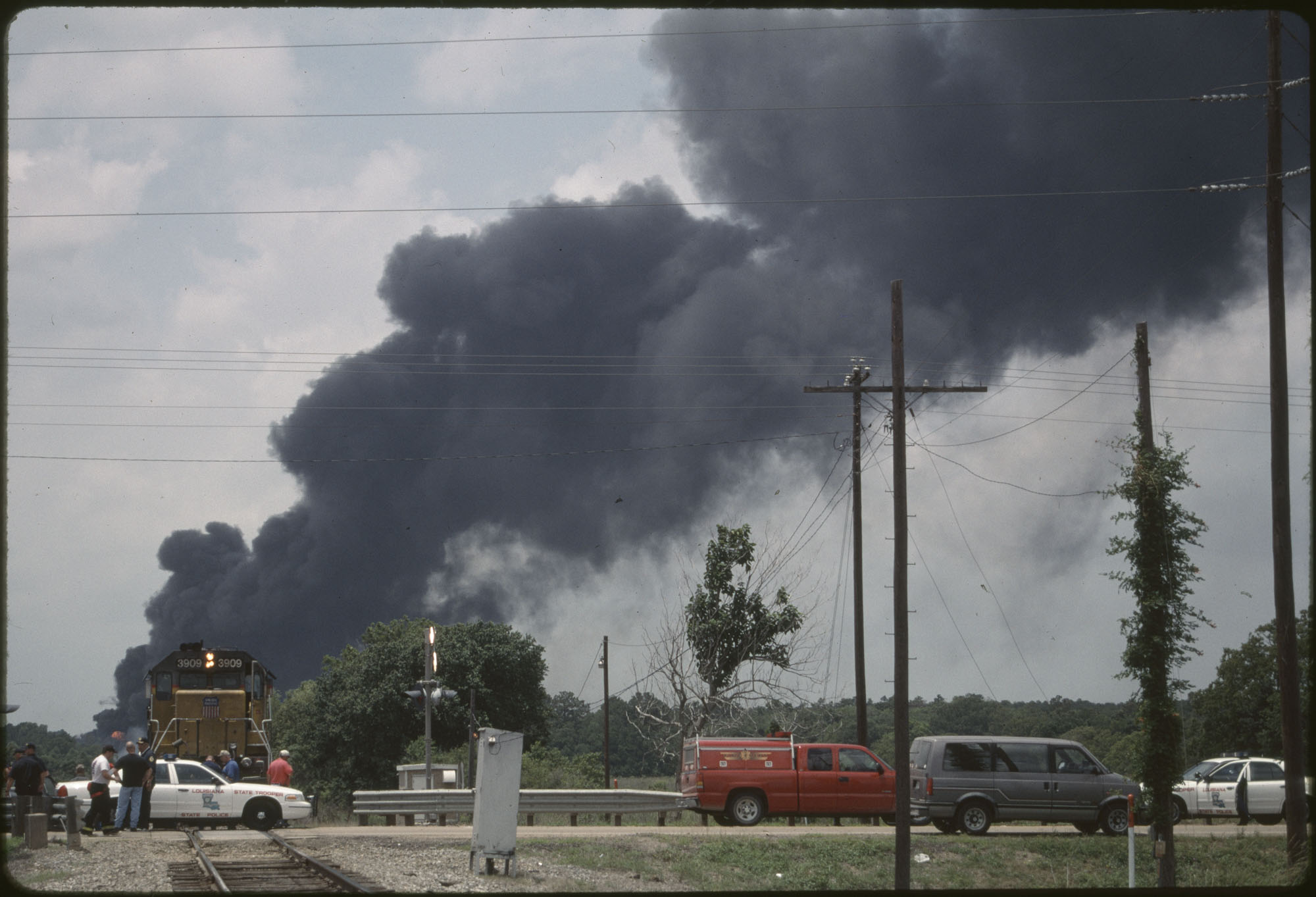
Imagine how a new lexicon, oriented to these compounds’ negative impacts and externalities—the term that environmental economists assign to costs not captured in the price of a thing—might change our popular imagination of these substances. We would have to rely extensively, then, on more familiar compounds that would never work in marketing. Dissolves-the-eye. Changes-DNA. Poisons-mother’s-milk. Makes-the-sun-to-burn-the-earth. Can’t-plant-here-again.
One of the derailed cars of UP-26 contained dicyclopentadiene, which is used to make resins, inks, and paints. (Plastisol inks are made with compounds like dicyclopentadiene, as distinct from water-based inks, so if you can feel the printing on your t-shirt, it’s probably done with plastisol.) The compound has also been used as a repellent for keeping rabbits and deer away from plantings. Small wonder: human subjects can smell it in concentrations as low as 0.003 ppm and report respiratory irritation within minutes of exposure at one part per million. Plastink. Makes-animals-run.5
We might be encouraged to care about what these things are because we are more than likely implicated in their use, and because we are routinely exposed to them, too. They have been permanently joined to the air, water, and land in the region where the nation’s most extensive wetlands and most striking socioeconomic disparities coexist in a kind of national human and environmental write-off that some have called a “National Sacrificial Zone.” The train that runs through Eunice—or East Palestine, it might be said—runs its rails for you, too. The cars bore the required, diamond-shaped warning placards, but constituted an unremarkable shipment along that line. Officials in Ohio have expressed outrage that the Palestine train was not required to be identified as highly hazardous, which would activate a requirement to notify residents. In this unimaginably hazardous trade, what, exactly, is highly hazardous? The shipment was just another prosaic day in the life of industry until an accident called for sacrifice. Official accounts say 3,500 were evacuated from Eunice and 4,100 displaced; 1,500 to 2,000 were evacuated from East Palestine.
Some of the derailed cars deemed nontoxic in Eunice brimmed with a cargo of plastic pellets, sort of the petrochemical equivalent of grain corn (nurdles, their smaller cousins, have become a symbol of the global microplastic crisis). The pellets can be transported by truck and barge, too, bound for smaller plants and additional processing in faraway states. As the authors of Petrochemical America explain, those “plants require more skilled labor and pollute less than their Southern predecessors.” This is the very definition of what it means to be colonized, of course: the resource goes out, along with higher-wage jobs, while the risks and externalities stay behind. As to the pellets, they “are injection-molded or extruded into children’s toys, DVDs, dinner plates, and a dizzying array of other consumer products.” DVDs. Come to think of it, they were just becoming popular, and affordable, in 2000. Now they’re largely landfill material.6
There’s the incontrovertible utility of those compounds to the specific civilization we inhabit. The raw products would be turned into the things that go into our pharmaceuticals, cars, homes, electronics, and the things that deliver energy to them. Perhaps this serves as the beginning of a certain understanding. The second crucial piece of context comes from simply appreciating how common such derailments are and were as a predictable cost of doing petrochemical business. As I learned in Eunice, you don’t have to live next to a refinery to be put at hazard. The refinery can come to you.
Had I been paying attention, there was a warmup to the Eunice incident that played out just three weeks before I arrived. It happened in nearby New Iberia, Louisiana, another small Cajun town with its own golf course and bayous. On May 3, 2000, thirteen of 80 cars in a Burlington Northern Santa Fe train went off the tracks, with five of them rupturing, resulting in the release of xylene, a mass evacuation, and ultimately $5 million awarded to some 3,000 claimants.
As I learned in Eunice, you don’t have to live next to a refinery to be put at hazard. The refinery can come to you.
In many respects, though, the derailment that is the closest precursor to Eunice happened eighteen years earlier on September 28, 1982, in Livingston, Louisiana, when, according to fire historian Robert Burke, “36 cars of a 101-car Illinois Central Gulf (ICG) train derailed in the center of this small community, located 50 miles east of the state capitol of Baton Rouge.” “The wreckage splintered the pines like matchsticks,” the local paper reported, “and sowed the field with flames.” Mayor Derral Jones, serving as fire chief at the time, recalled in 2015, “In no way were we prepared to deal with this.” “We had one raggedy-ass old truck and about six guys who didn’t know what they were doing led by one guy who sure as hell didn’t know what he was doing,” the former chief said of himself. “I said, ‘Hell, I don’t know what to do, we’ll just evacuate everybody.’ . . . No one could deal with that mess.”7
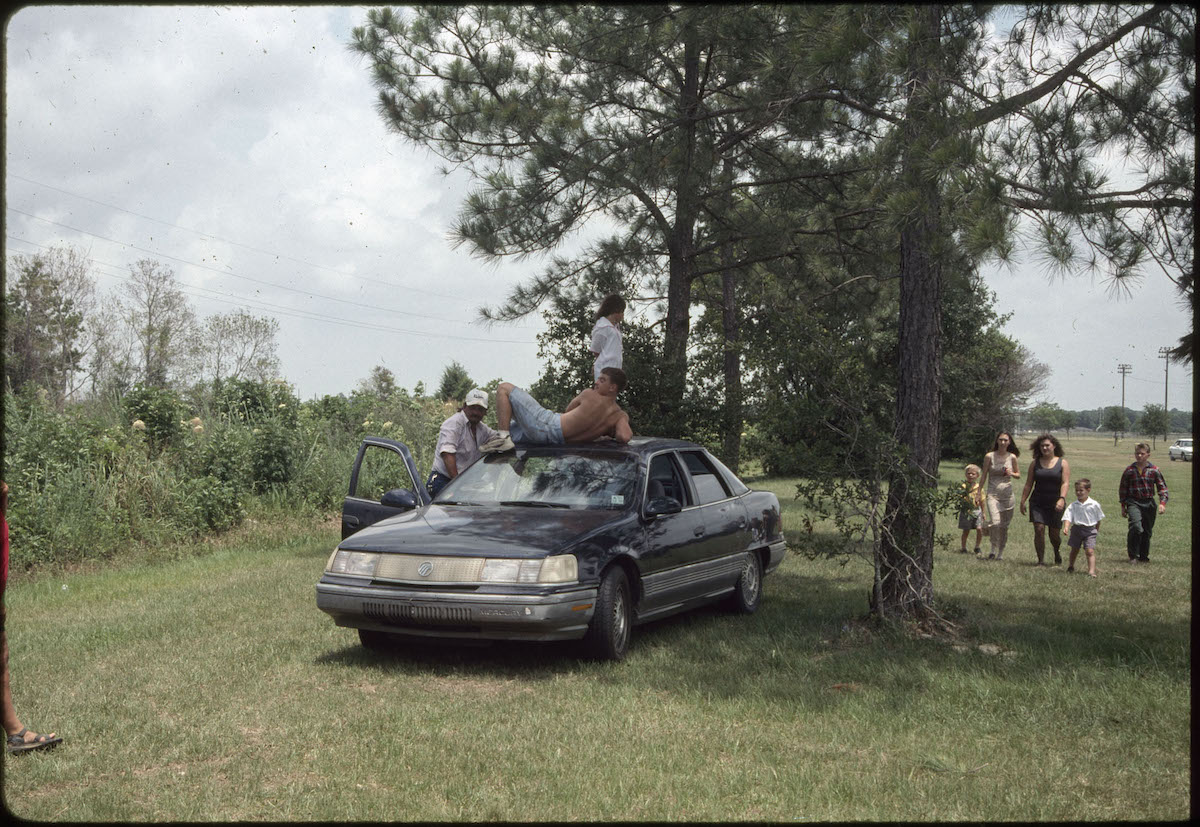
The Eunices and Livingstons of the South would become textbook studies about what to do with such messes. The manual Emergency Planning: Preparedness, Prevention and Response (2005) provides answers to such nagging questions as, exactly what do you do “with a railcar of Acrylic Acid that had flames impinging upon it for over two days . . . with the fire ongoing, the car upside down, and the overall situation in a high level of concern”? The case study goes on to explain that what you do is called “Vent and Burn,” with “cone shaped charges . . . placed on the upper most point of the railcar with the intention of relieving the pressure and igniting the resulting vapors. A line of charges is placed along the underbelly of the railcar to ignite shortly after the top charges have relieved the pressure. These second charges blow open the length of the railcar and ignite the remaining material.” The article doesn’t specify who places the charges, or what it feels like to approach a smoldering car of acrylic acid that could explode at any moment to place them. Perhaps it will be the basis for Unstoppable II.
In any case, the Livingston fires burned for days, and explosions continued, including one eerily like what I witnessed, yielding “a massive fireball of 400 feet in height and a mushroom cloud visible 15 miles away. The tank car of tetraethyl lead had been weakened by the flame impingement, causing a boiler-type explosion, and the main part of the tank rocketed 600 feet. It caused damage a half-mile away.” These details are not offered as disaster porn, but to describe the inhuman scale of the terror they visit upon communities, and the military tactics required to contain them. As in Eunice, there were tanks of styrene in Livingston, and considerable dilemmas about what to do with the burning car, resulting in dramatic vent-and-burn tactics and controlled explosions, tactics reprised in East Palestine.8
In a Firehouse magazine retrospective on the Livingston incident, Robert Burke noted that “during cleanup, a railroad worker lost both legs when a cable broke during clearing operations. Additionally, the first three state troopers to arrive on the site have since died from cancer. It is unknown how many others may have died from cancer caused by exposure to toxic materials during the incident.” And so I am doubly grateful to the state policemen who barred bystanders from the incident site in Eunice, and the family that bore me away from there.
They saved me from more trauma, a word that had perhaps less currency in 2000 that it commands today. Likewise, privilege has taken on a new resonance, and I can see how my privileged circumstances spared me from other traumas—particularly in the recurring themes of American derailment, in which the lines between failed campaigns of the war on poverty and the success of war on the environment become blurred. In 2005, the Graniteville train crash in South Carolina released 60 tons of chlorine gas, killing nine and gassing 250 people. Acknowledging the cloud of phosgene released in East Palestine, David Masur, executive director of PennEnvironment, told the Washington Post, “It feels a little like a sci-fi movie when you are told that one of the byproducts being released is an agent that we used against our enemies in World War I.” Eunice taught me that the linkages between war on the environment and fantasies of unbounded economic growth—indeed, the petrochemical revolution that facilitated the Second World War and ushered in the way we live today—are hidden in plain sight.9
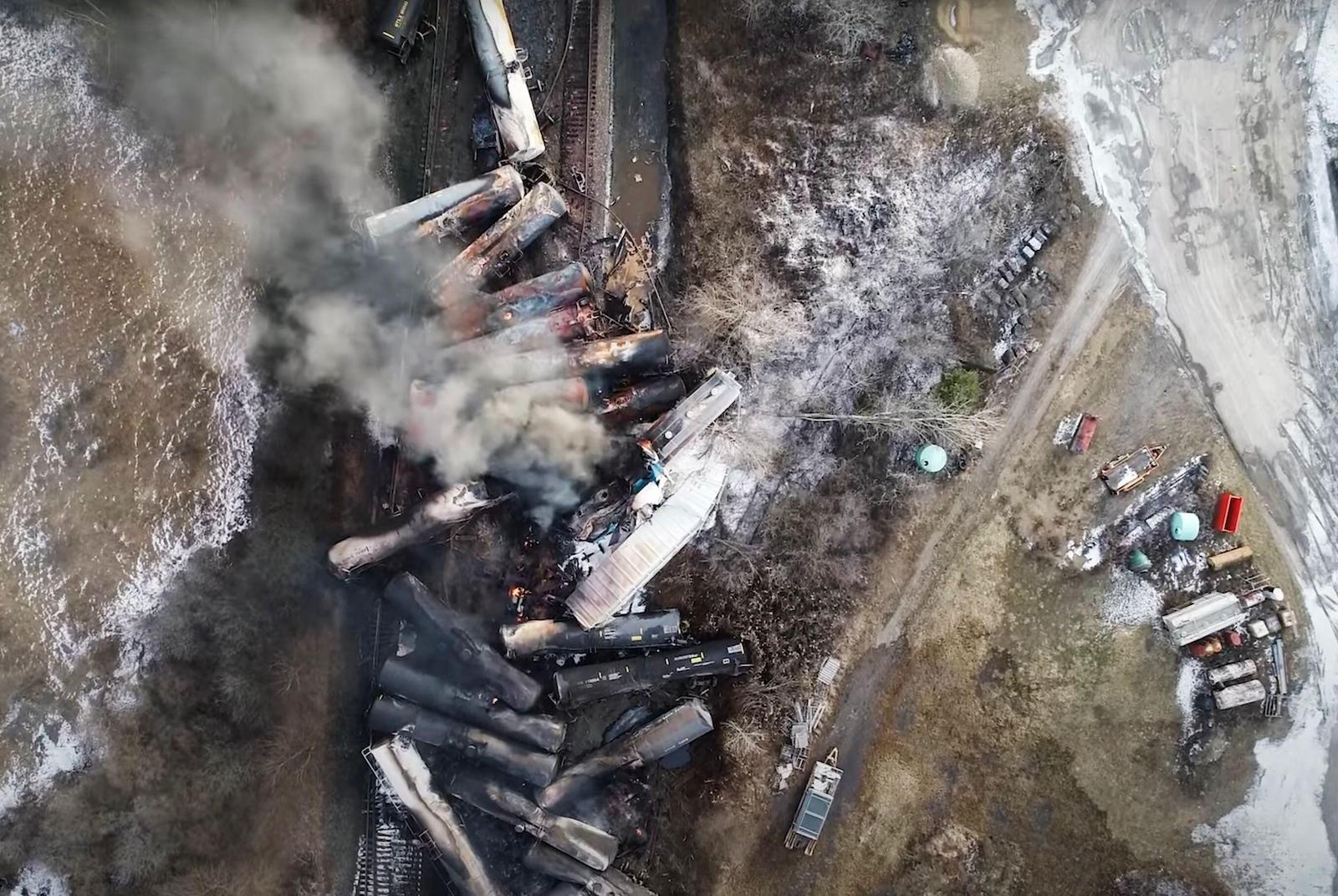
It feels a little like a sci-fi movie when you are told that one of the byproducts being released is an agent that we used against our enemies in World War I.
Meanwhile, in law school, I was learning something of the dismal science of the actuary and the economist in assigning value to loss of life and limb. The Livingston derailment is still widely regarded as the worst disaster of its kind in Louisiana, but it might be pointed out that, adjusted for inflation, Eunice was a significantly costlier incident. Many factors could play into that calculus, including an increasingly litigious society. Following the money, as usual, is revealing. The National Transportation Safety Board Report is completely silent as to the companies that produced the spilled chemicals in Eunice, but the June 7, 2000 issue of Chemical Week reported that “Dow Chemical is among several chemical companies that had chemicals on board.” A Union Pacific spokesperson noted that the company carried catastrophic insurance for such incidents, but naturally refrained from saying what the threshold was. The median household income in Eunice, a town of 11,000 at that time, was around $21,000. The town’s population has since declined by ten percent, and while I’m not suggesting cause-and-effect here, Cancer Alley, which helped give rise to the term environmental racism, is dotted with towns that have been evacuated and displaced, some of them permanently, because of spills and disasters.
Among them is Morrisonville. As encyclopedia entries note in baleful past tense, Morrisonville was a historic Black settlement, founded in the 1870s by formerly enslaved people, tucked in an oxbow of the Mississippi south of Baton Rouge. Dow Chemical established a plant nearby that soon leapt its green buffer, so that the small settlement was overshadowed by a Moloch-like refinery, replete with dozens of flare stacks and storage tanks. After another incident in 1989, and faced with permanently contaminated groundwater, the company began a buyout program. When New York Times reporter Keith Schneider went to Morrisonville to report on the new buyout strategy, he met Rosa L. Martin, who told him with level eye, “Dow doesn’t pay for attachment to land, for the inheritance that is in this community.” Martin, the article noted, was living with her husband, Jack, “in a modern brick house so close to the plant that hissing compressors and commands over the plant loudspeakers can be heard inside.” By 1993, with the last local resisters relocated, the town that had held on for generations as a place distinct from Baton Rouge (not to say refineries) became, like many other historically Black places, a post-place community, to be carried on in the stories or reunions of its diaspora, if at all.10
Nearby, on Christmas Eve of 1989, a “thunderous” blast that could be felt fifteen miles away erupted from the massive Exxon refinery on a nearby stretch of the river two miles north of Baton Rouge. With 3.6 million gallons of fuel oil instantly ablaze, the power grid disrupted, and waterlines damaged, firefighters resorted to pumping water directly from the Mississippi River. A four-square-mile area around the plant was closed, but no evacuations were ordered. When Keith Schneider asked Exxon’s Walter J. Eldredge if the buyout project was related to the accident, Eldredge responded that “the project was started before the accident and was intended to beautify the area.”
“I don’t believe that,” said Curtis Brown Jr., 18, who lives with his parents, a brother, and a sister in the Standard Heights neighborhood south of the refinery. “They’re scared of another tank blowing up or gas coming over here. When that tank blew up, I thought an airplane had fallen on the house. People were running down the street holding their heads.”11
After Eunice, I could relate to that feeling, too. In June of the following year, the residents of New Sarpy, not too far upstream from New Orleans’s Louis Armstrong airport, witnessed more great balls of fire when Tropical Storm Allison struck alight a storage tank with a 300,000-barrel capacity. This was the mother of all dumpster fires and still holds the title for the largest fuel tank fire in US history. The story’s themes are familiar: chemical odors in town, gradual expansion of the refinery’s footprint, frequent change of ownership. Some residents who lived next to the plant were told, in the now familiar phrase, to shelter in place. Small wonder that a few years later some town residents were begging the refinery for a buyout. It is now the site of the still-larger Valero St. Charles Refinery. In this grim better-than-nothing calculous, a buyout is considered a good ending to the story; being stuck on the human archipelago in the encroaching industrial soup is a guarantee of continued want and illness.12
Also around the same time as my visit to Louisiana, problems at the Marathon Refinery were driving a wedge into the historic waterfront of Garyville as the refinery literally and figuratively spilled into surrounding communities and pressed outward. Ever since it started in the 1970s, the refinery, which now sits on 3,500 acres and is touted by Marathon to be the third largest in the United States, has been growing on the grounds of the former San Francisco Plantation property. The company’s website copy notes that the property “is the last grassroots refinery built in the U.S.” Imagine building your own speculative refinery as a venture and then selling it to a multinational corporation—and calling it a grassroots effort. Paul Hawken—entrepreneur, environmentalist, and author of Regeneration: Ending the Climate Crisis in One Generation (2021)—has pointed out that the corporate fervor for coopting the rhetoric of environmental and social justice movements comes about precisely because it threatens their dominance.
To be sure, Garyville has never exactly shied away from extractive businesses. Its earlier claim to fame was that the town sawmill processed (flensed is perhaps a more fitting verb) a 1,300-year-old cypress believed to be the oldest tree in Louisiana. The entire course of my study of environmental law bore home the insistent, maddening irony that wetlands grew “externalities” like duckweed, as places irresistibly inexpensive, yet biologically priceless beyond compare. Cognizant of the cost-benefit balance of human efforts to achieve better living through chemistry, it is a dilemma that sits heavy with me each time I turn an ignition key, apply shampoo to my hair, or fill a prescription. Many of the people in these communities understandably choose to remain. We like to think that we live in a mobile age, but even in 2015, the average American lived only eighteen miles from their mom. Geography and kin really are destiny.13
In his book The Repeating Island (1966), Cuban novelist Antonio Benítez-Rojo shrewdly observed that “we can speak . . . of a Caribbean machine as important or more so than the fleet machine [that powered empire]. This machine, this extraordinary machine, exists today, that is, it repeats itself continuously. It’s called the plantation” (8). The far-reaching consequences of the plantation ensure that the Marathon refinery is just another iteration of the machine, new “geographies of exploitation”: on the ashes of San Francisco plantation has risen a new plantation.
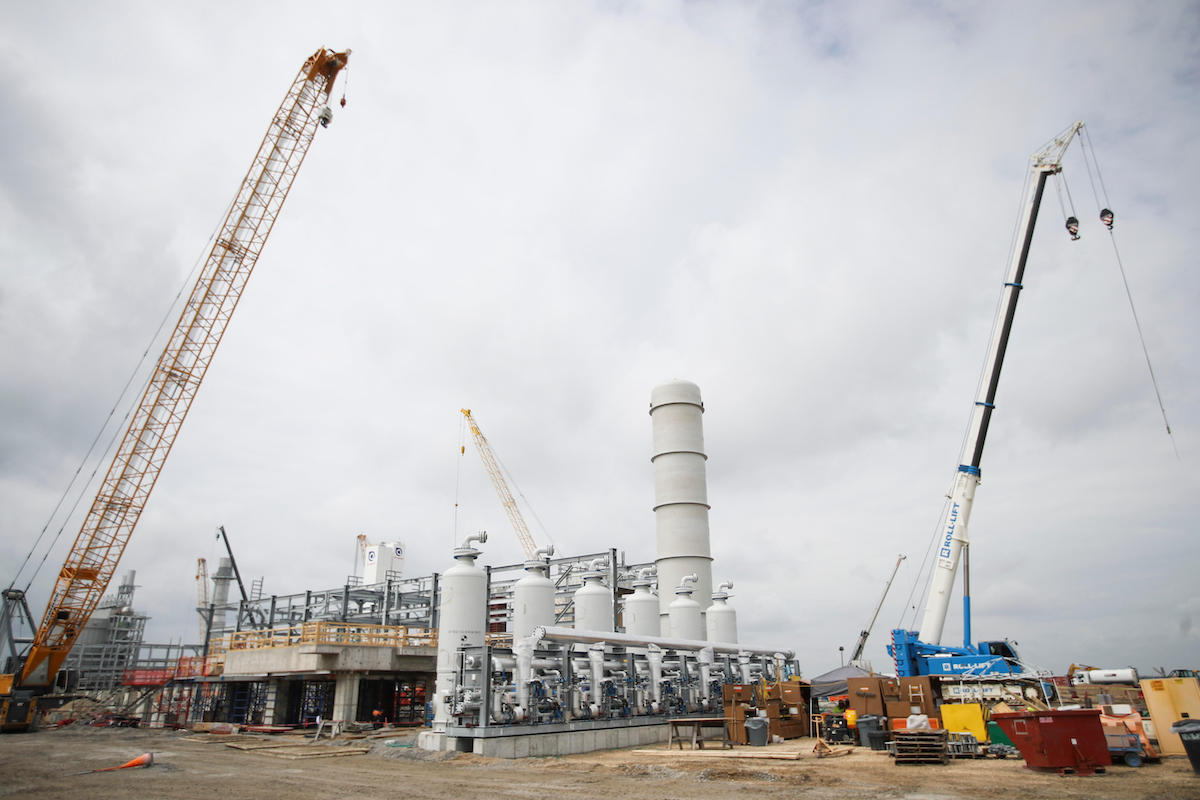
This is the way of the Mississippi today: giant blocks of petrochem development nestled with adjoining habitations, which are often low-income rural areas. As this machine repeats, with the globalization of capital come stories such as the 2015 zoning surprise that greeted the African American community in rural St. James Parish. The Chinese company Yuhuang Chemical Inc. announced that it intended to build a $1.85 billion methanol facility around the former St. James High School. Construction soon began on what the company touted as “the largest green field investment in methanol by a Chinese company in Louisiana.” Like the “safety zone” around Morrisonville, “green field investment” is an Orwellian term of art to describe when a multinational corporation constructs a built-to-spec plant from the ground-up, hence, prepping a green field. If the term wasn’t conceived for greenwashing, the irony could not be starker.14
And so the displacements continue through the waltz of downsizing and upsizing. In another twist that I naively did not foresee in 2000, fracking and the export of American crude oil would ramp up a new wave of petrochemical shipping and attendant disasters. Indeed, the current pace of our derailments is comparable to the Eunice days, almost a quarter century ago; a 60 Minutes segment released in May 2001, called “Every 24 Hours,” referred to the rate at which track failures were causing train wrecks. Today, writing in the wake of East Palestine in n+1, Erik Baker cites Aaron Gordon’s 2021 investigative journalism and his sounding of a new alarm: “derailments of trains with risky payloads have been mounting for some time—341 trains, including 24 freight trains, derailed in 2019.” This spate of accidents is the consequence of “Precision Scheduled Railroading,” bureaucratese for a bog-standard cost- and corner-cutting scheme. Freight trains are now longer than ever, a metastasis mirrored across the logistics industry, from colossal container ships like the one that got stuck in the Suez Canal in 2021 to the 91,000-pound mega-trucks that lobbyists are currently cajoling Congress to allow onto interstates.”15
Another twist in history, itself related to climate change: global pandemics and the increased appetite for global shipping, ergo more disasters. Working in historic preservation taught me that the machine repeats itself in part by effacing the remembrance of history. And not withstanding the worthy resistance of real grassroots groups like the Louisiana Bucket Brigade, there’s the problem of being fetishized as an environmental poster child. Cancer Alley persists somewhere in the popular imagination alongside Appalachian Poverty (remember East Palestine) as on of those durable, insoluble problems that is handed on from generation to generation and admits little hope of change. Better to look to areas where something can be done, the thinking goes. Yet the Bucket Brigade is undaunted even when it stands before the fire-breathing leviathan.
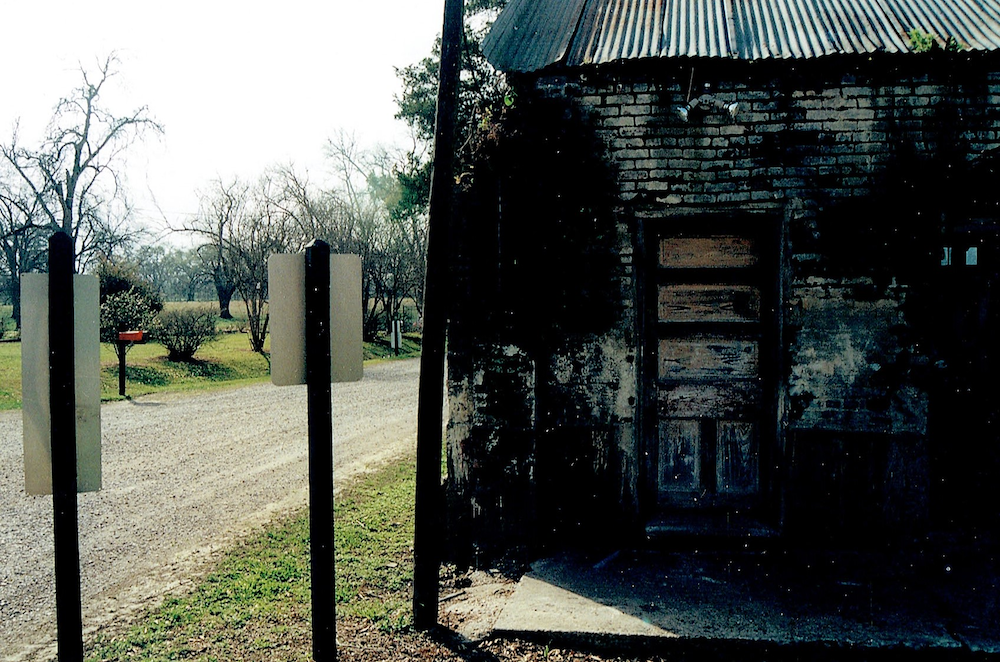
In the months that followed the Eunice incident, I received a mailer to join a class action lawsuit for potential damages from that day. Sam’s relatives had dutifully listed those present. I threw it away. I took my small exposure trauma and treated it as my father did his Vietnam trauma. I turned my eyes away, hoping to leave it burning at the crossroads, or perhaps to sink into what Hemingway referred to as the “black-ass” swamp—that shadowed place at the edge of the mind, the place of poor fishing and depression. In American idiom we have the increasingly popular and useful terms dumpster fire and shithow—an example being the 1980 wholesale draining of Louisiana’s Lake Peigneur within hours after a drilling crew tapped into a cavern—to describe moments when the only appropriate response is to start walking because there is no remedy.
This is more easily said when your home isn’t in a Eunice or East Palestine or other sacrificial zone, of course. I was done with law school, done with all but the teaching of law, done with notions of legal fungibility and what it means to be made whole again versus actually putting things right. Eventually, my work turned toward community archives, documenting voices like the ones I heard in Eunice and encouraging others to leave a mark on the record even when hope of redress seems remote. And the work goes with me into the climate emergency, and as middle age approaches, a new serenity about what I cannot do, albeit with more anger than I expected to be carrying this far along in life.
Over two decades later, though, Eunice is still my black-ass swamp, working on me, shaping how I understand my place in this country and what I can do for those I care about. If we become what we love, doesn’t that apply to what we must leave behind, too? What does it say about codes of masculine conduct that I have avoided for twenty years the emotional work that is part of Eunice’s wreckage, and the guilt of walking away? Twenty years later, I am only starting to understand how much it shaped my path. Sometimes I still dream I’m walking those tracks. It’s hot, even as night falls. The rails still blaze in the American night, from Eunice—sharing its name with the grand dame of Christian conversion—to track-split Palestine, Ohio. In the disorientation of dreams, and of time, I can never be certain if I’m walking toward the column of smoke, or away from it.
Bryan Giemza is Associate Professor of Humanities and Literature in the Honors College at Texas Tech University. He is the creator and director of a campus-wide resilience initiative called Creating Livable Futures. His forthcoming books include Science and Literature in Cormac McCarthy’s Expanding Worlds (Bloomsbury, June, 2023) and an edited essay collection on disinformation, Across the Canyons: Transdisciplinary Approaches to Divisive Communications in West Texas and Beyond (2024).NOTES
- Here and elsewhere, my description of the incident comes mainly from the National Transportation Safety Board’s official report: Derailment of Union Pacific Railroad Train QFPLI-26 at Eunice, Louisiana, May 27, 2000, Railroad Accident Report NTSB/RAR-02/03, National Transportation Safety Board (Washington, DC, 2002). It can be accessed online: https://www.ntsb.gov/investigations/AccidentReports/Reports/RAR0203.pdf
- Bryan Giemza and Maria Hebert-Leiter, Images of Depression-Era Louisiana: The FSA Photographs of Ben Shahn, Russell Lee, and Marion Post Wolcott (LSU Press, 2017).
- Walter Isaacson, “Walker Percy’s Theory of Hurricanes,” New York Times, August 4, 2015, https://www.nytimes.com/2015/08/09/books/review/walker-percys-theory-of-hurricanes.html.
- See https://www.epa.gov/assessing-and-managing-chemicals-under-tsca/risk-management-nonylphenol-and-nonylphenol-ethoxylates.
- https://toxnet.nlm.nih.gov/cgi-bin/sis/search/a?dbs+hsdb:@term+@DOCNO+321
- Richard Misrach and Kate Orff, Petrochemical America (New York: Aperture, 2014).
- Although Livingston is a smaller town (about 1300 people at the time of the incident), the parallels to Eunice are striking. The trains had comparable numbers of cars, comparable numbers derailed (36 and 33, respectively), and, as in Eunice, massive explosions soon followed, along with mass evacuations; Steve Hardy, “Cleanup following 1982 train derailment in Livingston near an end,” The Advocate, December 16, 2015, https://www.theadvocate.com/baton_rouge/news/communities/cleanup-following-1982-train-derailment-in-livingston-near-an-end/article_876eb30c-dd37-5b7b-8f5f-a248c15b453f.html.
- Robert Burke, “Hazmat Studies: Livingston, LA, Train Derailment—36 Years Later,” Firehouse Magazine, April 1, 2018.
- Burke, “Hazmat Studies”; Nick Keppler, Justine McDaniel, and Anna Phillips, “Drink bottled water, officials tell Ohio town hit by toxic train crash,” Washington Post, February 14, 2023, https://www.washingtonpost.com/climate-environment/2023/02/14/ohio-train-derailment-toxic-chemicals/.
- Keith Schneider, “Chemical Plants Buy Up Neighbors for Safety Zone,” New York Times, November 28, 1990, 1, 30.
- Schneider, “Chemical Plants Buy Up Neighbors for Safety Zone.”
- For more on New Sarpy’s record (40 accidents in 26 weeks) and efforts to rectify it, see Gwen Ottinger’s Refining Expertise: How Responsible Engineers Subvert Environmental Justice Challenges (NYU Press, 2013), and https://labucketbrigade.org/our-work/supporting-fenceline-communities/new-sarpy/. A lot more could be said about the blurry lines between domestic terrorism, fueled by the American love of dynamite (in southern towns, for example, dynamite was sold in hardware stores well into the second half of the twentieth century, and was often an instrument of the Ku Klux Klan, of revenge, and “accident”), and the frequency with which petrochemical incidents produce explosions. Of course, these things are in some sense related; environmental racism becomes a basis for what could be called environmental terrorism.
- Quoctrung Bui and Claire Cain Miller, “The Typical American Lives Only 18 Miles From Mom,” New York Times, December 23, 2015, https://www.nytimes.com/interactive/2015/12/24/upshot/24up-family.html.
- The Yuhuang Chemical Inc. webpage, http://yci-us.com/, has since been taken down but is now archived on the Wayback Machine: https://web.archive.org/web/20180228032244/http://yci-us.com/
- Erik Baker, “It Is Happening Again,” n+1 online, February 17, 2023, https://www.nplusonemag.com/online-only/online-only/it-is-happening-again/.

